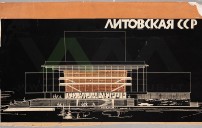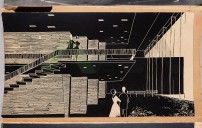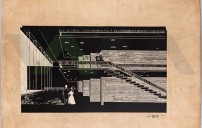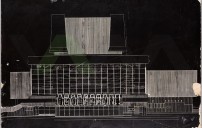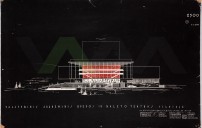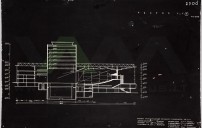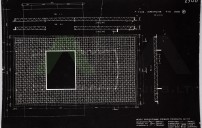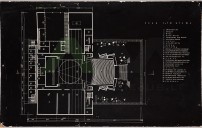Sorry, this entry is only available in Lithuanian.
News
Publications
Dichotomy of Form and Content
2018.12.12
Author Tomas Skripkiūnas
Introduction
Dichotomy of form and content is the division of a single object/unit into two parts. The separation of form and content can be disastrous to the work of art, but it is very important to distinguish these two elements of the work in its analysis and research.
The paper tries to study the origin of dichotomy of form and content in speech, attempts and the need to distinguish between form and content; continuously it shifts to the dichotomy of form and content in an art piece; finally, the paper ends presenting the concepts of form and content in architecture. The text discusses the inevitable dichotomy of architectural form and its content, related to architectural research and, in general, the function of architecture as a form in society.
Origin. Dichotomy of Form and Content in Speech
Dichotomy is a potentially harmful separation, because it treats two inseparable things as independent. Most often, it is the separation of form and content, often described as the separation of antique verba and res (analogous to the Aristotle’s logos (logical content of a speech)) and lexis (the style and delivery of a speech). Form is the words, the content is the concepts expressed by words. The content is what it is said – arguments, the topic. The form is the way it is said – syntax, diction, imageries. In his article on the dichotomy of form and content in speech, Dancant Robertson presents the following example: “Achilles is like a lion” – this is a way to say that Achilles is brave, fierce; in the literary work there can be four aspects of form distinguished: diction; syntax, word combinations, way of writing; versification; imagery[1].
This form and content separation itself is not particularly harmful, says Duncan Robertson. It becomes dichotomous, when the form is too much understood only as a container of contents, the form and the content are treated/perceived as independent of one another, but not in the sense that they can exist without one, more in the sense that there may be the same content in another form or vice versa[2].
Individual words and concepts/contents are/may indeed be more or less independent in relation to the aforementioned aspect (i.e., there may be the same content in another form or vice versa). The same word can mean different things in different contexts, and the same idea can be expressed in different words.
However, in any wider form and content combination, a certain exact structure of ideas can only be conveyed in a specific exact word structure. The same content, transmitted/expressed in a different form – by other means, in different style, way or language, is not the same: the one that is the same in all forms of variation is just tenuous abstraction, the précis[3] of the whole content. And all that can remain in form after changing its content is only its general characteristics in various aspects: for example, the archaicness of words or the complexity of syntax, or the fact that the content is presented dramatically, by narration, and so on. Such general features/characteristics are unlikely to contribute to/be part of the précis of form: we can summarize the content and generalize the form (not to summarize the form)[4].
However, in the analysis of works of art, it is crucial to be able to distinguish content from form (the same is, for example, with copyright, which will be mentioned later). It is also important to combine different evaluation criteria with a form and others with a content. We associate the truth criterion with the content, the beauty criterion – with the form.
But, as Duncan Robertson further points out, they cannot be considered separate. For example, the whole sense of the poem and the true value of the entire poem must lie in the totality of the poem (in total form and total content, which are inseparable as a whole). The value of the content abstracted from the form is reduced by comparing it with the total value, since the content separated from the form decreases as compared to the total content. The value of the form, separated from the content, as it was mentioned, is weakened even further. The work may not be in bad form, but with good content, or vice versa[5].
Content separate from form should still be expressed in a certain form. The bottom line is that the content must have a form. The form does not directly cover the content: what constitutes a content is a world (we all). Content is what is included in the work and what can be removed/interpreted, but there is no content in the work itself, only a form. Then the work as a form is a work in itself.
In addition, Duncan Robertson points out that the outside world, covering the content, is a world of space and time. So, when examining the content of the work, we analyse it as a temporary state in a certain time and space, and while examining the work as a form (then we examine the work itself), we decouple it from temporary interfaces (content) and consider it decoupled from time and space[6].
Attempts to Distinguish between Form and Content
There are specific cases where the separation of form and content is sought. There are two examples below.
Dichotomy in a literary work is a case of translation from one language to another. It is important to distinguish between content and form in the translation process. The content is the key to be preserved, the form is peripheral (except in poetry and alike), but it can be argued that translation is re-creation of work (the work is expressed in another form) and becomes a different work.
It is recognized by copyright that when the work is translated into another language, it is already considered a new work. According to Vytautas Mizaras, the legal separation of form and content is necessary, since one of the main principles of the protection of the subject matter of copyright claims that “copyright protects the objective form of expression of the results of creative activity, but not the ideas expressed in the work. […] In other words, it is the form of ideas, thoughts, the form of presenting the information, to say the expression form, that is protected but not the idea itself”[7] (idea is the content, expression is the form). For example, Delia Lipszyc presents the theory that the theme of dramatic works consists of thirty-six situations that correspond to thirty-six emotion types […]: the first situation is the savior (elements of the dynamics of the situation: the unhappy, the threatening and the savior); the second situation is revenge for the crime (elements: the revenger and the savior); […] the eighteenth situation – crime committed for love (the loving, the beloved and the third person); […] twenty-fifth situation – infidelity and so on[8]. These are unprotected ideas, their form of presentation is preserved (the work itself).
However, such separation is mechanical and rigid with respect to works of art, therefore the problem of dichotomy in the idea of a work and the form of expression is recognized in law as well (this is especially evident in literature as we see in the previous section).
Dichotomy of Form and Content in a Work of Art
In art and art criticism form and content are regarded as separate aspects of an artwork. The form refers to the style of the work, the technique and the way of expression (media), which are realized as elements of design. The content refers to the essence of the work/the idea, i.e. what is depicted.
John Ruskin’s work “Stones of Venine” is the example of the first analysis of “pure” abstract form. But he raised the question – why forms from which laws were derived, were exactly what they were? There were attempts to find the answers: all forms are energy, pressure forming lines, expressions of acting and contrastive forces[9].
- Akvinietis understood the emerging problems and argued that there is nothing more absurd than the desire to express the form by itself[10]; the form is only the shape of a message. The form created by art is then a message; art is a message.
In the visual art, the separation of form and content is disastrous. Examination of form is accused of aesthetics, formalism, and it is thought that iconographic research examines what is beyond the bounds of art. It is possible to mix the positions of both the form and the content: in the middle ages it was thought that the forms (real ones) existed before the objects, and the forms superimposed on the matter were only a reflection of a true-form. A similar mix of shape and content positions is also characteristic of Wassily Kandinsky and his “abstract” paintings; it was necessary to discredit, discard the object and the plot, because it simply contaminates the form (and color). “In the abstraction, at most reduced ‘materiality’ must be understood as the most effective reality. So, finally, we see: if in the great realism reality seems unusually extensive, and the abstractness is unusually small, and in a larger abstract this relation seems to be inverse, then finally (= exactly) these two poles are equal to each other. We can put the sign of equality between these two antipodes: realism = abstraction; abstraction = realism”[11]. The purer the form of objectivity, the more appropriate it is to be a content.
At that time, the questions arose: history of art – what is it? History of forms? Does the question of style equal the question of changes in forms (formalistic, formalist art history)? However, Kandinsky himself realized that the existing inner element created by soul vibrations is the content of the work. There is no creation without content.
Splitting into categories or isolating them (form, content, object, color, …) is absurd. Then, according to Hermann Bauer, “pure analysis of form is not possible, since the message itself cannot be touched. It is not possible just to talk about a message because a message exists only in a certain form.”[12] Analysis of work of art: the iconographic-iconological method is the search for the meaning of an earlier work of art, using all available visual and written sources that could explain it somehow. The purpose of historical interpretation is to allow our understanding to rely on the understanding of the relevant period. An immanent interpretation of works of art, “which a pure form was sort of completely sufficient of, became meaningless. Because it is in the works of famous artists that the forms always had the meaning of the carrier.”[13]
Form and Content of Architecture
The written history of the opinions leads to conclusions that justify the necessity of the dichotomy of form and content. This formed the basis for research methods of works of art (e.g. iconographic and iconological method), including, of course, architectural research.
An obvious example is the article by Hans Sedlmayr on the front facade of the Charles Church of Vienna. The article is even considered a paradigm due to a wider context of the issues raised and due to issues of environment and the sphere of action, and most importantly, due to a disclosure of links between form and content. The icons of the form and the form of icons find their expression[14].
Suppose the building’s content is the imageries and ongoing processes that are encoded in it, which are inseparable from its users. Then it can be argued that in general terms architecture as a material object is only a form of expression. This is illustrated by further examples.
“The Home” study by Adrian Forty shows the change in the concept of home as an architectural and abstract object in connection with socio-cultural factors, such as the industrial revolution[15]. The desire of people to separate work from home influenced their architectural form. Home is now imagined as a calm oasis for rest after work. The dichotomy of form and content in architecture is obvious here.
A similar theoretical model of change in the concept of a living space is illustrated by studies/projects undertaken by students at the Architectural Association School of Architecture (UCL). Study Diploma 14 – Volker Bradke: Architecture between the Generic and the Common[16] looks at the links between architectural form, political theories and urban history. The focus of these links is architecture. Links are aimed to be created not only as deterministic relationships of causes and consequences between these different areas, but as strategic links in their cooperation. In 2011, attention was drawn to the merging of living and working spaces into a mixed urban space, in contrast to the above-mentioned study. This phenomenon is seen as a social and economic transformation in society. Such relations between architectural forms and social/economic changes became the main subject of the research. Specific student offers (architectural forms) are a reflection of social content.
The theory of “movement of spirit” of Hegel was similar. It explains how changes in the cultural system impact the way one style changes others. This, of course, is directly related to all changes in the architectural visual features – the form and the justification of their stylistic uniformity. Hegel states that the communal spirit is expressed in material forms[17].
Form and Content of Architecture: Complications
One can conclude that it is impossible to separate the form from the content by exploring the architecture, because the form is directly derived from the content. Architecture as a material object is a form of social content expression.
On the other hand, separate architectural elements can be treated as separate forms with separate content. So moving from the whole of the work to its elements you should see several levels of form and content. Architecture is the expression form of the culture of society, but its separate elements have their own content. For example, an ornament is now understood as a non-essential decorative element, something that may be beautiful, but is not really necessary. Interestingly, this word is etymologically derived from the Latin verb ornare, meaning “to equip”. Then, for example, weapons and soldiers are military ornaments, i.e. tools for expressing the desired meaning and effect[18]. It can be argued that the ornaments in architecture were not for beauty (form), but for content.
The style of works of art is shaped by the influence of cultural conditions of that time, and therefore style can be regarded as an expression form of the culture as a content of that time, and in architecture the style could to be understood as the content of an architectural work as a form. In fact, it can be argued that the same style has a separate content[19]: the form of an architectural work includes its material expression (it can be said, the physical form), then the characteristics of that form (style) are basically what it is to say in geometric shapes – the content.
Architecture is an extremely complex system of various content, packed into various forms. Therefore, one of the most important roles in its analysis are performed by the organization/ sorting of links between data (content) and form. As with analysing works of art, an architect must understand form and content as two different elements of a building. Not for nothing, the Renaissance students, while studying rhetoric art, were asked to copy the form by giving her a new content, and vice versa. Although this kind of separation is essentially impossible as a result of creativity, it becomes important in the creation process and in the analysis of works.
An example of this is a contemporary architecture. Global standardisation seems to be a new content, and perhaps thus hides the lack of content (as Jeane Baudrillard’s simulacras break away from reality and conceal the absence of it[20]). The result is people’s dissatisfaction with new architectural objects, the convergence of cities, and the boredom of the environment they create. This particular formality is extremely damaging to architecture as one of the communication forms between culture and human.
Form and Content of Architecture: the Use
There may not be a correct formula for assessing the dichotomy of the architectural form and content, but this could be one of the qualitative criteria for assessing modern urban transformations. As mentioned, in the case of a literary work, the form itself does not include content: content is constituted by ourselves, therefore, we fill out architectural forms with content. So there is no need to say that new forms should appear when new content is created. Interchanging people perfectly fill in the old forms (content container). Architecture is not a movable, static work, like a poem or a painting. It is much more interactive, it is much more influenced by the context, interconnected with forms from different periods of time, and content is updated.
The old form can be adapted to new content. An excellent example of this is the conversion of industrial areas in various cities around the world. A new form can revive old content. For example, the MO Modern Art Museum, which appeared on the site of the “Lithuanian” cinema, includes its former content in its new form – it is a gathering place for people as well as a cinema centre. It continues the tradition of that place to be an important place in the city, a landmark. At the same time, some of the content is either erased or replaced by a new one. The whole city is a mixture of content and forms of different scales that can be designed. It is important that this would be a mean to achieve the desired goal, while at the same time involving the public.
Conclusions
- Although each field of science has many features specific to its form and content, one way or the other the dichotomy problem is faced. In fact it is adapted and modified according to needs. There are common principles that define links between form and content; they have deep roots in the Antique (Aristotle, art of rhetoric, speech…).
- Form and content can be distinguished in a descriptive way, but their meaning is distorted or greatly reduced: essentially the work is lost as an object, only its objective elements remain, which it would be impossible to reproduce the work itself from. In this case, the totalities of form and content are violated, their meaning is distorted/reduced.
- The extent we look at the objects/works is very important. It can have multiple levels of form and content. Total form – total content; further this content has its own distinct forms, which have their own content, and so on. Common misunderstanding is a different understanding of form as an object of the study: form can be a matter, a way of saying, a set of materials (style).
- Form is more associated with materiality, objectivity, science, exoterism; content – with myth, esoteric.
- Only the dichotomy of form and its content gives meaning to architecture as an art to shape the environment of human cultural activity. Architectural content is the person himself.
- Due to the dichotomy of form and content, architecture as an expression form of social content, is constantly changing with society. On the other hand, this dichotomy gives the architecture a special power to influence the content in certain forms.
G. Oržikauskas photo
Literature
- Architectural Association, Diploma 14 – Volker Bradke: Architecture Between the Generic and the Common, London: Architectural Association School of Architecture, Projects Review 2011, [interactive], http://www.aaschool.ac.uk/PORTFOLIO/PROJECTSREVIEW (Projects Review 2011 – Diploma 14), [viewed on 05-10-2018].
- Bauch Kurt, Kunst als Form, Jahrbuch für Asthetik und allgemeine Kunstwissenschaft 7, 1962.
- Baudrillard Jean, Simulacra and Simulation, Ann Arbor: The University of Michigan Press, 1994.
- Belting Hans (sud.), Meno istorijos įvadas, Vilnius: Alma littera, 2002.
- Burton Gideon O., Silva Rhetoricae, Provo: Brigham Young University, [interactive], http://rhetoric.byu.edu (What is Rhetoric? – Content/Form), [viewed on 05-10-2018].
- Cho Keunjung, Architecture as the Intersection of Form, Content, and Social Morality. English 151, Providence: Brown University, 2003, [interactive], http://www.victorianweb.org/authors/ruskin (John Ruskin – Leading Questions – Traffic), [viewed on 05-10-2018].
- Groat Linda, Wang David, Architectural Research Methods, New York: Sage Publications, 2001.
- Kandinsky Wassily, in Der Blaue Reiter, München, 1912.
- Lipszyc Delia, Droit d‘auteur et droits en France. 3. éd., Paris: Dalloz, 1978.
- Mizaras Vytautas, Autorių teisė. I tomas, Vilnius: Justitia, 2008.
- Robertson Duncan, The Dichotomy of Form and Content. College English, Vol. 28, No. 4, National Council of Teachers of English (Jan., 1967), p. 273-279, [interactive], http://www.jstor.org (data base), [viewed on 05-10-2018].
- Ruskin John, The Stones of Venice, 1851-1853.
[1] Duncan Robertson, The Dichotomy of Form and Content. College English, Vol. 28, No. 4, National Council of Teachers of English, 1967, p. 273 [interactive], http://www.jstor.org (data base), [viewed on 05-10-2018].
[2] Ibid., p. 273.
[3] précis – very brief summary of content/facts.
[4] Duncan Robertson, The Dichotomy of Form and Content. College English, Vol. 28, No. 4, National Council of Teachers of English, 1967, p. 273.
[5] Ibid., p. 275.
[6] Ibid., p. 277.
[7] Vytautas Mizaras, Autorių teisė. I tomas, Vilnius: Justitia, 2008, p. 162.
[8] Delia Lipszyc, Droit d‘auteur et droits en France. 3. éd., Paris: Dalloz, 1978, p. 22.
[9] John Ruskin, The Stones of Venice, 1851-1853.
[10] K. Bauch, Kunst als Form, Jahrbuch für Asthetik und allgemeine Kunstwissenschaft 7, 1962, p. 167.
[11] Wassily Kandinsky, in Der Blaue Reiter, München, 1912, p. 19.
[12] Hans Belting (sudarytojas), Meno istorijos įvadas, Vilnius: Alma littera, 2002, 3 dalis, p. 160.
[13] Ibid., p. 152.
[14] Ibid., p. 160-162.
[15] Linda Groat, David Wang, Architectural Research Methods, New York: Sage Publications, 2001, p. 135.
[16] Architectural Association, Diploma 14 – Volker Bradke: Architecture Between the Generic and the Common, London: Architectural Association School of Architecture, Projects Review 2011, [interactive], http://www.aaschool.ac.uk/
PORTFOLIO/PROJECTSREVIEW (Projects Review 2011 – Diploma 14), [viewed on 05-10-2018].
[17] Linda Groat, David Wang, Architectural Research Methods, New York: Sage Publications, 2001, p. 146.
[18] Gideon O. Burton, Silva Rhetoricae, Provo: Brigham Young University, [interactive], http://rhetoric.byu.edu (What is Rhetoric? – Content/Form), [viewed on 05-10-2018].
[19] Keunjung Cho, Architecture as the Intersection of Form, Content, and Social Morality. English 151, Providence: Brown University, 2003, [interactive], http://www.victorianweb.org/authors/ruskin (John Ruskin – Leading Questions – Traffic), [viewed on 05-10-2018].
[20] Jean Baudrillard, Simulacra and Simulation, Ann Arbor: The University of Michigan Press, 1994, p. 6.
